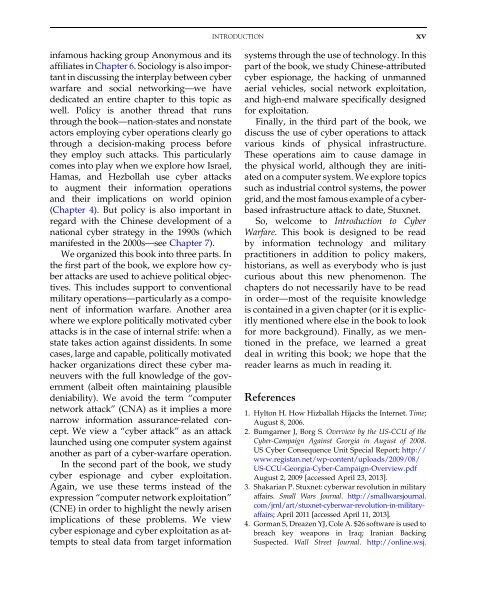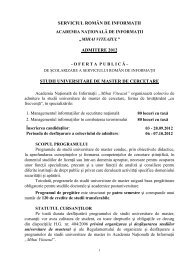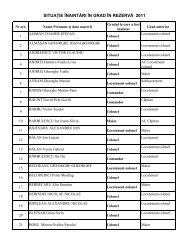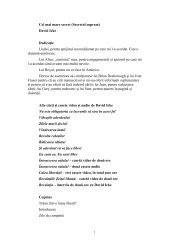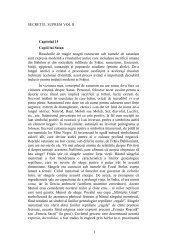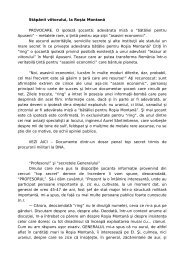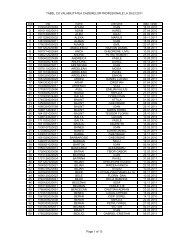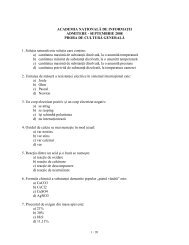Introduction to Cyber-Warfare - Proiect SEMPER FIDELIS
Introduction to Cyber-Warfare - Proiect SEMPER FIDELIS
Introduction to Cyber-Warfare - Proiect SEMPER FIDELIS
You also want an ePaper? Increase the reach of your titles
YUMPU automatically turns print PDFs into web optimized ePapers that Google loves.
INTRODUCTIONxvinfamous hacking group Anonymous and itsaffiliates in Chapter 6. Sociology is also importantin discussing the interplay between cyberwarfare and social networking—we havededicated an entire chapter <strong>to</strong> this <strong>to</strong>pic aswell. Policy is another thread that runsthrough the book—nation-states and nonstateac<strong>to</strong>rs employing cyber operations clearly gothrough a decision-making process beforethey employ such attacks. This particularlycomes in<strong>to</strong> play when we explore how Israel,Hamas, and Hezbollah use cyber attacks<strong>to</strong> augment their information operationsand their implications on world opinion(Chapter 4). But policy is also important inregard with the Chinese development of anational cyber strategy in the 1990s (whichmanifested in the 2000s—see Chapter 7).We organized this book in<strong>to</strong> three parts. Inthe first part of the book, we explore how cyberattacks are used <strong>to</strong> achieve political objectives.This includes support <strong>to</strong> conventionalmilitary operations—particularly as a componen<strong>to</strong>f information warfare. Another areawhere we explore politically motivated cyberattacks is in the case of internal strife: when astate takes action against dissidents. In somecases, large and capable, politically motivatedhacker organizations direct these cyber maneuverswith the full knowledge of the government(albeit often maintaining plausibledeniability). We avoid the term “computernetwork attack” (CNA) as it implies a morenarrow information assurance-related concept.We view a “cyber attack” as an attacklaunched using one computer system againstanother as part of a cyber-warfare operation.In the second part of the book, we studycyber espionage and cyber exploitation.Again, we use these terms instead of theexpression “computer network exploitation”(CNE) in order <strong>to</strong> highlight the newly arisenimplications of these problems. We viewcyber espionage and cyber exploitation as attempts<strong>to</strong> steal data from target informationsystems through the use of technology. In thispart of the book, we study Chinese-attributedcyber espionage, the hacking of unmannedaerial vehicles, social network exploitation,and high-end malware specifically designedfor exploitation.Finally, in the third part of the book, wediscuss the use of cyber operations <strong>to</strong> attackvarious kinds of physical infrastructure.These operations aim <strong>to</strong> cause damage inthe physical world, although they are initiatedon a computer system. We explore <strong>to</strong>picssuch as industrial control systems, the powergrid, and the most famous example of a cyberbasedinfrastructure attack <strong>to</strong> date, Stuxnet.So, welcome <strong>to</strong> <strong>Introduction</strong> <strong>to</strong> <strong>Cyber</strong><strong>Warfare</strong>. This book is designed <strong>to</strong> be readby information technology and militarypractitioners in addition <strong>to</strong> policy makers,his<strong>to</strong>rians, as well as everybody who is justcurious about this new phenomenon. Thechapters do not necessarily have <strong>to</strong> be readin order—most of the requisite knowledgeis contained in a given chapter (or it is explicitlymentioned where else in the book <strong>to</strong> lookfor more background). Finally, as we mentionedin the preface, we learned a greatdeal in writing this book; we hope that thereader learns as much in reading it.References1. Hyl<strong>to</strong>n H. How Hizballah Hijacks the Internet. Time;August 8, 2006.2. Bumgarner J, Borg S. Overview by the US-CCU of the<strong>Cyber</strong>-Campaign Against Georgia in August of 2008.US <strong>Cyber</strong> Consequence Unit Special Report; http://www.registan.net/wp-content/uploads/2009/08/US-CCU-Georgia-<strong>Cyber</strong>-Campaign-Overview.pdfAugust 2, 2009 [accessed April 23, 2013].3. Shakarian P. Stuxnet: cyberwar revolution in militaryaffairs. Small Wars Journal. http://smallwarsjournal.com/jrnl/art/stuxnet-cyberwar-revolution-in-militaryaffairs;April 2011 [accessed April 11, 2013].4. Gorman S, Dreazen YJ, Cole A. $26 software is used <strong>to</strong>breach key weapons in Iraq; Iranian BackingSuspected. Wall Street Journal. http://online.wsj.


